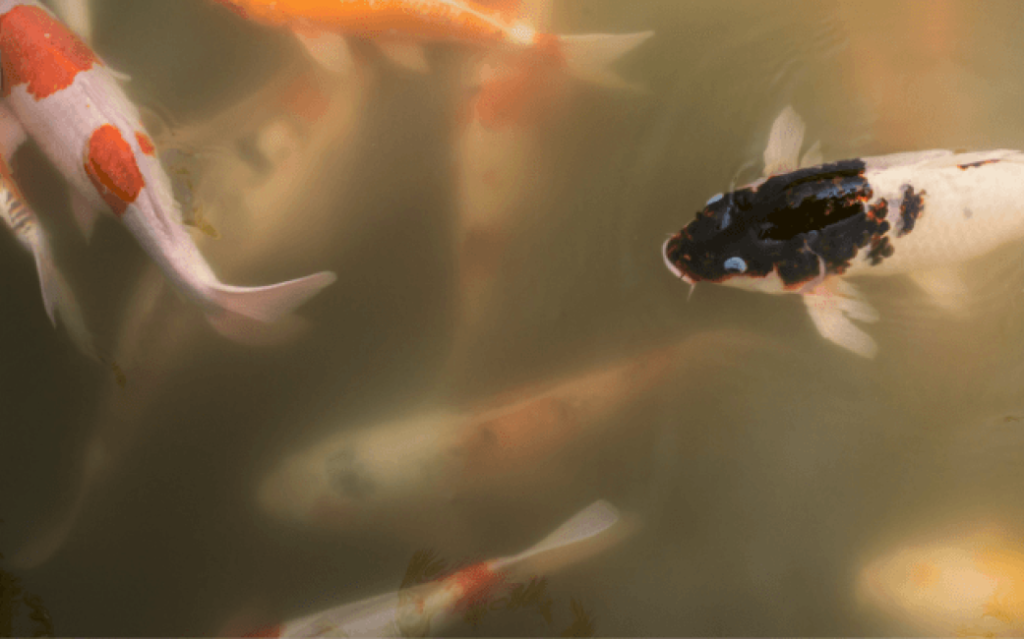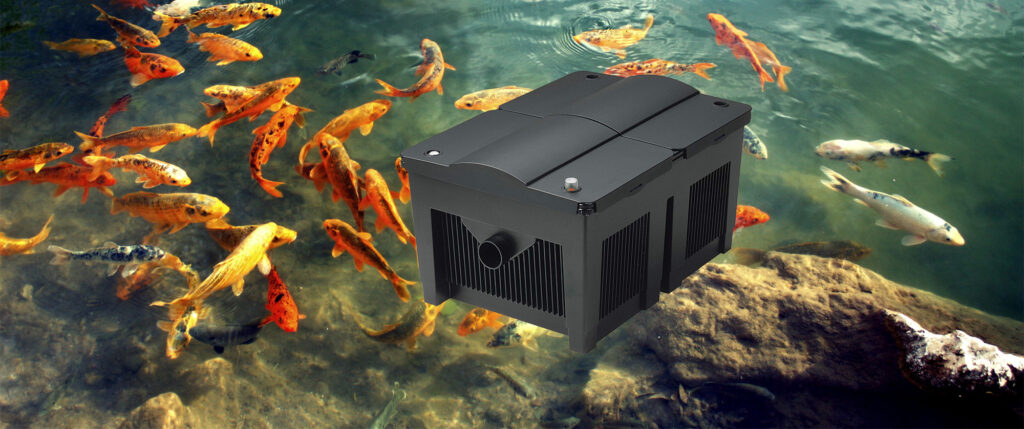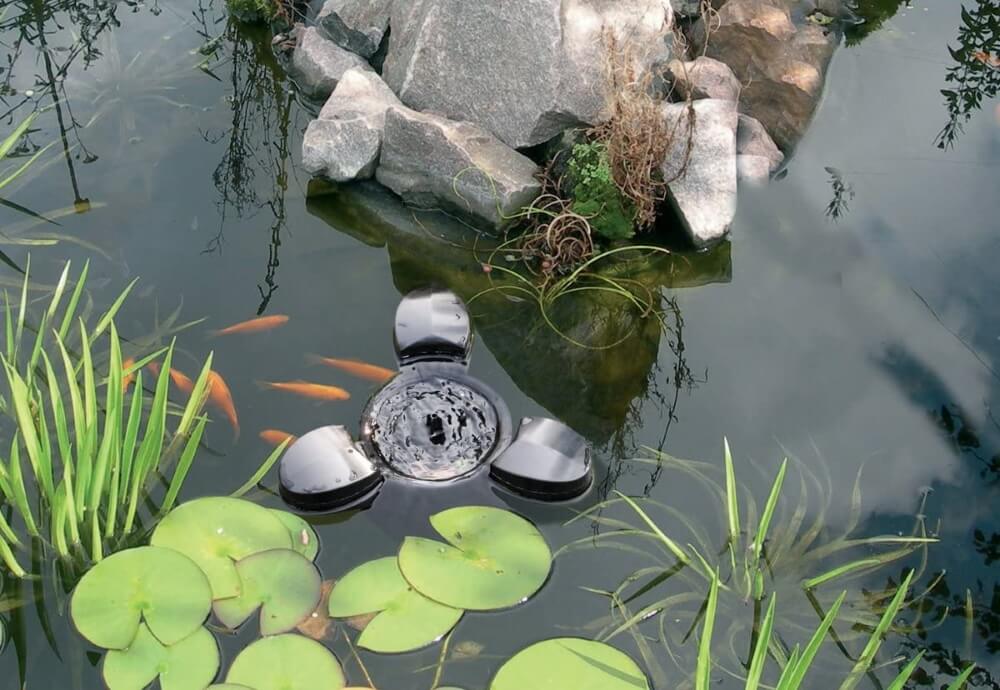
If you don’t like the idea of plugging your pond into mains power all summer long in order to aerate it, don’t sweat. There are lots of other ways how you can aerate a commercial pond without electricity, and we will show you how to work each of them.
There are many legitimate reasons why you would want to shift to alternative ways of aerating your pond. High electricity bills come to mind, as well as the problems of accessing power outlets in rural areas far away from power supply. Plus, the lakes and rivers have always done it without electricity, so why shouldn’t you?
Some of the options, such as windmills and solar panels, and great for the environment but bad for your pocket. Nevertheless, it ensures that you won’t have to think about energy bills for a long time in addition to looking really cool.
There’s no denying that there is a unique aesthetic to a pond that keeps things all natural. We are definitely suckers for eco-friendly solutions in your backyard (or ranch), even if we did write about the best pond aerators, electric or not. For now let’s take this to the next level.
Pond aeration is the artificial activity of increasing or maintaining the amount of dissolved oxygen in your pond. Some people also refer to it as pond oxygenation, although that term refers more specifically to a process of enriching oxygen saturation.
Unlike rivers and lakes, ponds don’t have the benefit of constantly moving water which allows it to mix and spread oxygen dissolved at the surface. Stagnant water tends to lose oxygen from the animal life in it such as fish and bacteria. Decaying plants are also huge users of the dissolved oxygen supply, which is why some people opt to have pond pumps to keep the water moving.
Aeration is mainly achieved by encouraging the movement of water, but a direct air supply through air pumps can also be used to bubble air through the water.
Pond water should be able to hold about 10-12mg of dissolved oxygen per liter of water Trusted Source Water Quality Concerns for Ponds This is a summary of some common water quality parameters that may cause problems in ponds and how to detect and treat them. extension.psu.edu , although typical levels are usually half that amount. If the level of dissolved oxygen falls below 3mg/L, then that water becomes hazardous to the fish and plants living in it.
Pond oxygenation levels are also determined by factors such as temperature — cold water holds more air than warm water. Dead algae also uses up a lot of oxygen and reduces its levels.
Aside from the fact that fish need oxygen to live, a well-aerated pond offers a host of many other benefits. You can always tell a poorly aerated pond from a combination of foul odors, lots of weeds and algae, the presence of mosquitoes, and murky water.
Here are some benefits of pond aeration.
Without sufficient water movement and aeration, sediment and decaying organic matter releases chemicals and gases that accumulate and foul up the water. Gases such as methane, carbon dioxide, and hydrogen sulfide (yes, that one that smells like rotten eggs) will slowly dissolve into the water, which could instead get released early with proper aeration.
Ponds with a lot of algae and little oxygen also tend to form pond scum, which is a result of incomplete decay of organic matter. This scum floats to the top and sticks to the sides, creating a particularly unappealing sight.
With better water quality, fish and other aquatic life have a better chance at survival. You also get clear and clean water which retains its lovely beauty day after day.
When a layer of the dreaded algae appears on your pond, it’s tempting to douse it in chemicals and hope it dies. However, this is only a temporary solution, and the green scum eventually grows back.
Good pond aeration agitates the water and reduces the chances of algae growth. By transporting algae spores throughout the pond, it ensures that algae won’t get enough sunlight and time to grow.
Increased sunlight penetration also allows deep aquatic plants to grow. These plants compete with algae for nutrients and even add to the oxygen levels in the pond through photosynthesis.
Stratification is a process where the water in your pond forms distinct layers as a result of differences in temperature and density. This in turn means that “dead zones” with very little levels of oxygen can be created in the lower depths of the pond, where no fish can live. Good aeration agitates the water and prevents stratification, thereby creating a better aquatic habitat for your fish.
When aquatic plants die, they need to be broken down by bacteria to provide nutrients in the pond. Without a good flow of oxygen, this plant matter simply settles at the bottom and accumulates. A poorly aerated pond requires more frequent dredging and cleaning to get rid of this scum and sediment.
Mosquitos love stagnant ponds because they can lay their eggs in the still water. Thus, a pond or lake without good aeration easily becomes a swamp and a breeding-ground for the bugs. If you have an aerator or fountain, the constantly moving water encourages mosquitoes to find someplace else to lay their eggs.
When properly executed, a pond aeration system will be breathtaking. Imagine the beauty of a windmill-powered fountain or a solar-powered submersible aerator blowing bubbles through the clear water.
Other systems of pond aeration include artificial waterfalls and rapids, overlapping fountains, and even geysers. All these designs add to the aesthetic quality of the landscape, especially in a commercial setting such a golf course.
Together with the gentle and calming sound of moving water, a well-aerated pond is exactly what you had in mind when you built it in the first place.
If you already have your filtration system in place and only need an aeration system that doesn’t depend on electricity, you’re good to go. Remember that aeration doesn’t take the place of filtration, and you can hardly afford to have an all-natural pond unless you want your fish to die.
That being said, a so-called wild pond is possible when you can achieve a natural balance between the animal and plant life in your pond. All that will come later, though. First, let’s explore sun and wind-powered pond aeration systems.
Solar fountain pumps use solar power to pump streams of pond water high up into the air like a fountain. In the process, the water breaks up into millions of tiny spheres which absorb air as they fall back down into the pond.
Technically, solar pumps operate just like electric pumps, except that they use a different source of energy. Their limited power makes solar fountain pumps better suited to small and medium-sized commercial ponds, where they can achieve a decent display and water height.
Fountains in general are among the best methods of pond aeration. In addition to spewing water high up in the air for maximum interaction, the rising water also ensures that water is pulled up from the bottom at regular intervals and ensures no stratification at all. You can also use solar pond pumps in other ways, such as creating a mini-waterfall.
As you might guess, the main disadvantage of solar pumps is that they can only operate where there is a decent amount of sunlight. In winter and overcast weather, you might have to revert to mains electricity to get you through.
A more sophisticated solar system with a battery storage system can give you more reliability, even though it will be more expensive during installation. With a good battery, you can get 4-6 hours of charge while the sun is out.
Solar pumps have now become cheap enough that you can get back your invested capital within a few years from saved energy bills. Just make sure to purchase a quality model with excellent durability and high efficiency.
Even then, a solar fountain pump is best used for energy-saving purposes and not as the sole aeration system. You will always need a backup system in case of unexpected circumstances. If that sounds like what you are looking for, the Solariver Solar Water Pump Kit with a 20W panel is an affordable and reliable option.
Even though the Solariver pump system doesn’t come with a backup battery, it is a completely submersible system that some users have even used for swimming pools. Thanks to its sturdy construction and very reliable solar power system, you can actually go away for days without worrying about your pond or pool.
Solar aerator pumps are also powered by sunlight, but they pump compressed air directly into the water instead. The system generally consists of a solar power generation system, an air compressor, and a system of diffuser tubes. The compressor blows compressed atmospheric air through the tubes into the water in the form of tiny bubbles.
Solar aerator pumps are a form of submersible aeration system. By generating a lot of bubbles through its diffuser tubes and rocks, it allows water to absorb air and rise with it to the surface. This also provides some level of water movement, though not as much as a fountain pump.
Solar aerators are highly reliable systems that work great for small ponds. They have a lower power requirement, so they can be made more compact and run up to 20 hours a day when paired with a good quality solar battery.
Even then, solar aerators share the same sunshine problems as the solar fountain pump. You would need a reliably sunny climate to have it as your only source of aeration. It also has the limitation of less water movement, so it’s not great for medium-sized or large ponds.
As a supplementary aeration system, though, solar-powered aerators are unbeatable. One such system is the Lancoon Solar Powered Air Pump Kit with a 2.5W solar panel. The compact kit comes with a 1800mAh battery, which allows it to run for more than 10 hours without sunlight. It’s greatest characteristic is the compact size, making it perfect even for aquariums.
When you have large commercial ponds and lakes, a windmill aeration system is the best choice. One windmill powered by moderate winds can serve a 2-3 acre lake, making this the most efficient aeration system that doesn’t rely on electricity.
The windmill is used to power a powerful air compressor producing 4 cubic feet of air per minute through a ½” air line placed at the deepest part of the pond or lake. Such a high air output actually causes the water to froth and bubble at the outlet, moving and agitating the water while aerating it.
This powerful performance is what makes windmill aeration systems perfect for large ponds. They can effectively prevent the growth of algae and ensure excellent water quality all year round.
More importantly, wind power is perennial and works even better in rural areas, which allows windmills to circumvent the two biggest problems of electricity and solar power.
Unfortunately, a lot of people would find such a large installation a little too much due to the high initial cost of installation. Heavy-duty windmills require dedication and effort set up, but with the upside that you can afford to forget about them after installation.
One of the more reasonable windmill aeration systems you can opt for is the Outdoor Water Solutions AWS0011 Windmill Aeration System. It is a 12-foot tower with a high air output of 4.5cfm and made of durable 18-gauge galvanized steel, yet customers can easily self-assemble the system on a 25 x 25 sq. ft area. If you can afford it, go for it.
As promised, we’re going to explore the amazing world of pond plants that can aerate your aquatic system naturally. Thanks to the amazing balance of nature, pond plants use up nutrients in the water and pond sediment and release oxygen through photosynthesis.
This method of oxygenation may not be as fast as a 4.5cfm windmill system, but pond plants are easily the best form of pond aeration if you don’t have a lot of fish in there. Submerged plants such as hornwort grow at the bottom of the pond where they also help to filter the water and further enhance the aquatic habitat, creating a balanced ecosystem Trusted Source Aquatic Plants in Ponds Many different aquatic plants from algae, which drifts suspended in the water, to plants floating on the water surface or rooted in the pond bottom can grow in ponds. Rooted plants grow either entirely under the water, have floating leaves, or grow with stems above the water surface. Some have both underwater and floating leaves. Both algae and rooted plants will grow in all ponds. Keeping a balance is sometimes difficult. Any plant can become a nuisance with the right conditions. www.iowadnr.gov .
As you know, fish particularly love plants in the pond because they can play and hide among them. In return, the plants use up ammonia and other potentially toxic fish waste which they use as fertilizer. That’s what we call a win/win!
You can even order a bundle of the best pond plants such as Anacharis and Hornwort for your pond or aquarium from Amazon. You can plant them directly in the sediment or leave them floating, and either way, they will get rid of algae on the double.
Just like natural lakes, commercial ponds go dead without proper aeration. That’s why a good aeration system is a necessity.
What’s optional is how you choose to power your pond’s aeration system. These are some of the ways how to aerate a pond without electricity, which can save you a lot of money in energy bills.
At the same time, pond aeration using alternative energy sources is one way to do your bit for the environment. All you need to do is be prepared to make the initial investment and enjoy a stress-free, beautiful pond.





